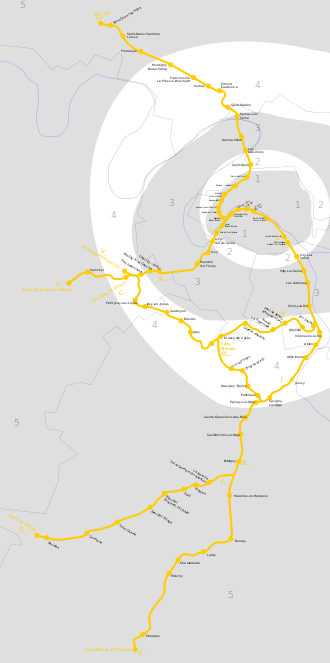RER C
| RER C | |||
|---|---|---|---|
 
|
|||
| Overview | |||
| Stations | 84 | ||
| Ridership | 140,000,000 journeys per year | ||
| Operation | |||
| Opened | 1979 (last extension in 2006) |
||
| Rolling stock | Z 5600, Z 8800, Z 20500, Z 20900 | ||
| Technical | |||
| Line length | 185.6 km (115.3 mi) | ||
| Track gauge | 1,435 mm (4 ft 8 1⁄2 in) | ||
|
|||
The RER C is one of the five lines in the RER system serving Paris, France. It is operated by SNCF.
The line runs from the northwestern terminuses Pontoise (C1), Versailles-Château (C5) and Saint-Quentin-en-Yvelines (C7) to the southeastern terminuses Massy-Palaiseau (C2), Dourdan-la-Forêt (C4), Saint-Martin d'Étampes (C6) and Versailles – Chantiers (C8).
The RER C is the second longest line in the network, with over 187 km (116 mi) of route. RER C was created from an amalgamation and renovation of several old SNCF commuter lines unlike RER A and B which had newer sections owned and constructed by RATP. Each day, over 531 trains run on the RER C alone, and carries over 540,000 passengers daily, which is 150,000 passengers more than the entirety the TGVs network. It is also the most popular RER line for tourists which represents 15% of its passengers, as the line serves many monuments and museums, including the Palace of Versailles. The numerous stops combined with an old and fragile infrastructure the line inherited, makes the Parisian section of the RER C very slow and inefficient. The numerous old curves and steep grades on RER C means trains sometimes need to slow down to 40km/h to safely pass sections with tight alignments. In contrast, RER A was constructed with more modern standards allowing for much higher average operating speeds. These problems are particularly evident on trips to and from the northern suburbs to the city center as taking Transilien lines and transferring to the Métro is much faster than taking the meandering RER C with closely spaced stops. In addition RER C's complicated operating schedule created by its complex network of numerous branches means the entire line is venerable to delays from even the smallest incidents. These issues have lead to the line been called "réseau escargot régional" (Regional Snail Network) by the local populace.
...
Wikipedia

